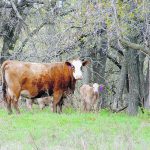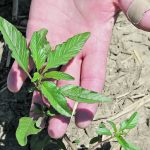Glacier FarmMedia – The past few seasons have been a challenging time for farmers on the Canadian Prairies. Extreme heat, lack of precipitation and steep increases in production costs have caused some sleepless nights for many producers. As if those weren’t enough to contend with, another potential threat to crops will soon rear its ugly […] Read more
Tag Archives Manitoba Agriculture

Man. soybean seeding on early side this year
With adequate rainfall and warmer soil temperatures, soybean seeding across Manitoba is well underway. Manitoba Agriculture’s May 21 crop report placed soybean planting at 34 per cent complete. If nighttime temperatures don’t warm up more than they have recently, soybean plants will likely emerge around 15 to 17 days after planting, said Dennis Lange, a […] Read more

Mexican crop troubles benefit Canadian bean growers
Statistics Canada estimates farmers will plant 358,150 acres to beans this year, a 12 percent hike from the previous year
SASKATOON — Growers in Canada and the United States planted more black and pinto beans and fewer navy beans in response to Mexico’s production hardships, say industry officials. Orion Roy-Wright, a trader with ADM Edible Beans, told the Global Pulse Confederation (GPC) that producers in those two countries increased black bean plantings by 15 to […] Read more

Pasture outlook seen as ‘cautiously optimistic’
Agronomists urge cattle producers to practise patience when they are tempted to graze immature pastures this spring
The grazing season has had some memorably bad starts in recent years, but 2024 won’t likely be one of them. Producers had a better feed buffer last fall. In 2022, for example, turnout was hindered by the double whammy of a cold, wet spring and the lingering impacts of the 2021 drought on feed supplies […] Read more

Cattle sector aims to break the cycle
Open rates were horrendous in Western Canada last fall: what can producers do to make sure history doesn’t repeat itself?
Glacier FarmMedia – Many beef producers got an unpleasant shock at last fall’s preg check, and experts are weighing in on what can be done to avoid a similar problem this year. According to a report from the Western Canadian Animal Health Network (WeCAHN), more than 40 per cent of some herds were found open. […] Read more
Seeding research may not apply to all regions
Recent Sask. study suggests benefits from lower wheat seeding rates for low moisture, but that might not transfer to Man.
Recent research from Saskatchewan suggests farmers might want to hold back on their wheat seeding rate if they’re expecting a dry year, but it’s not clear how well the insight translates to Manitoba. The Western Applied Research Corporation study found that with a dry season on the horizon, a mid-to-low wheat seeding rate achieved the […] Read more
Anti-predation program introduced in Manitoba
Glacier FarmMedia – Work from a three-year pilot project aimed at understanding the livestock sector’s predator problem has become provincial policy. On April 25, the federal and Manitoba governments jointly announced the Livestock Predation Prevention Program, funded through the Sustainable Canadian Agricultural Partnership. The program builds on the Livestock Predation Prevention Pilot Project, an industry-led […] Read more

Canola, cereal crops slow waterhemp’s spread west
CLANDEBOYE, Man. — Soybeans and waterhemp go together in Manitoba like peanut butter and jelly. Find a field of soybeans and you may find waterhemp. “That’s almost always where we find it,” said Kim Brown, provincial weed specialist with Manitoba Agriculture. Tall waterhemp is a Tier 1 noxious weed in the province, which means it […] Read more

Crop profits harder to find this year
WINNIPEG — Last January, Manitoba Agriculture farm management experts said that with average yields, nearly every crop looked profitable in 2023. Grain corn was especially promising. Twelve months ago, the estimated profit from growing corn was $114 per acre. That sort of profitability seems unlikely in 2024. This year, Manitoba Agriculture believes corn could be […] Read more

Seed multiple soybean varieties
An Ontario soy expert says growers should plant at least three varieties to help find the best fit for their farm
WINNIPEG — Horst Bohner is convinced that farmers should plant more than one variety of soybeans. If they don’t, they are making a “mistake.” “As a basic starting point, I think every grower should seed at least three varieties. Every year. As a minimum. Hopefully more than that,” said Bohner, the soybean specialist for the […] Read more



